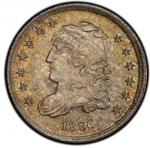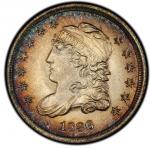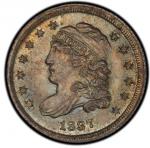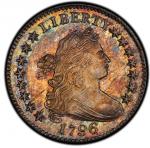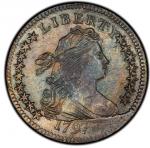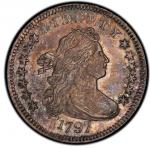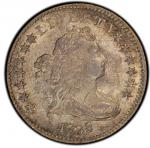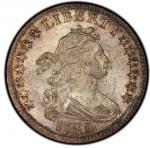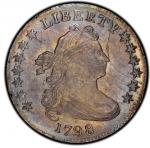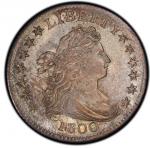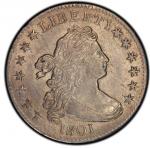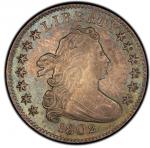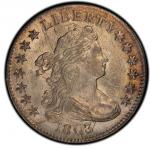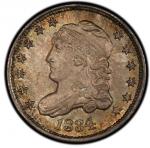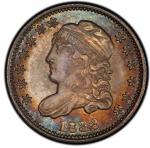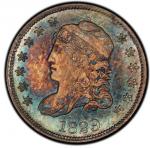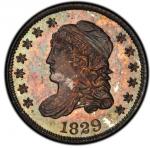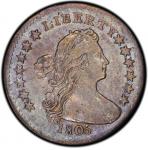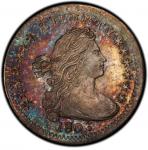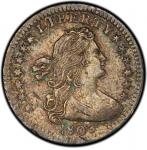Beautiful Proof, well struck up. — B. Max Mehl, 1922The fact that this comes from the Ten Eyck and Holmes Collections certainly adds to its prestige and value. — Norman Stack, 1960An astounding specimen, a perfectly preserved example of the finest work the coiners of the 18th century Philadelphia Mint were capable of producing. This coin is a great highlight of the D. Brent Pogue Collection. While this particular example has not been cataloged as a Proof since 1975 (it was accurately termed Gem BU at its last appearance in 1990), one could forgive generations of numismatists for seeing this coin and other similar 1796 quarters and calling them Proofs. The definition of a Proof changes over time, and even today it depends upon who is asked, but the basic premise of a Proof is a coin that is struck with special preparation, usually with mirrored fields, and with the intent to be something prettier and finer than a circulation strike. While intent is impossible to prove, and while technical considerations enable us today to distinguish between the way 1796 quarters were coined and the way later Proofs were coined, one can imagine that if the masters of the first United States Mint had wanted to make a Proof example of the first United States quarter, this is what it would look like.This coin is fully struck everywhere but the eagles head, where the nostril and tongue are formed and the eye is nearly intact but the head remains somewhat soft (this is a hallmark of the B-2 variety). Every single star center is complete, peaked, and sharp. Each strand of hair, fold of drapery, and denticle are defined. In the wreath, the leaves are veined and the palms are concave. Every berry is round. All these details, intact from the moment the dies loosened their grip on the silver blank, have spent more than two centuries reacting to their environment in the most beautiful way, resulting in sea-green and blue fields, rose and gold peripheries, and hints of luxurious lavender. The fields are as deeply mirrored as polished obsidian, boldly prooflike and reflective, suggesting that the die faces were polished until they gleamed before striking this coin. The planchet may also have been brightened or polished before striking in order to take the best step forward into a future when American quarter dollars — an exception in our decimal system — would rule American pockets in the way the equivalent-valued Spanish colonial two reales had heretofore. The curved lint mark below the final A in AMERICA is a reminder of the attention to the cleanliness of the dies, or planchets, or both. Some delicate streaks or surface striations in the right obverse field are natural and inherent, a relic of the moment the silver ingot was rolled into a strip; they are less notable on the reverse. Aside from the few wispy hairlines found with concentration under a glass, and a single pinprick mark on Libertys chin, this coin is immaculate, as if it had been handled with velvet gloves since the next to last year of Washingtons administration.In the way of background, the quarter dollar denomination is a victory of tradition over consistency, interrupting Jeffersons decimal plan with a fractional coin of equal value to the most popular circulating silver coin of early America, the Spanish colonial two reales. The famed two bits, still ingrained in American memory, was simply too familiar to 18th century Americans to create a new monetary system and not include a piece of similar or equal value. The quarter dollar was not among the initial denominations Jefferson suggested in his 1784 Notes on Coinage. Instead, he preferred a twenty-cent piece, identical to the Spanish pistareen, a commonly encountered coin from mainland Spanish mints that passed at five to a dollar and would have been a better fit into his decimal system. He called it the double tenth, equal to .2, or 1/5 of a dollar, or to the pistareen. However, his lesser known but more practical Propositions Respecting the Coinage of Gold, Silver, and Copper of May 1785 suggests a piece of silver of 1/4 or .25 of a dollars weight and value. In August 1786, a congressional committee returned to Jeffersons double dime concept in their recommendations on denominations. Alexander Hamilton weighed in on proposed denominations in 1791, though only two silver coins were included among his suggestions, the dollar and the tenth. Nearly a decade after Jefferson had first suggested a quarter dollar, the denomination was made official in the Mint Act of April 2, 1792, which created a quarter dollar that weighed 104 grains of 0.8924 fine silver, for a total fine silver content of 92 and 13/16 grains.It took the Mint four years to strike a quarter dollar for circulation, though the 1792 Eagle on Rock is thought by most numismatists to be a trial for the denomination, despite lacking any inscription relating to value and the fact that surviving specimens are in only the base metals of white metal and copper. The first quarter dollars, struck in 1796, were clearly a sensation, as a significant proportion of the 6,146 minted not only still exist, but survive in a very nice state of preservation. Walter Breens undocumented 1988 assertion that Col. E.H.R. Green once owned a hoard of over 200 Uncirculated 1796 quarter dollars is unfounded, representing a doubling of Abe Kosoffs recollection that, decades earlier, he had seen Philadelphia coin dealer James G. Macallister extract a narrow package about 15 to 18 inches long, wrapped in brown paper full of 1796 quarters from his coat pocket. Kosoff recollected nearly 40 years later that all in all I would say there were about 100 pieces, possibly a few more or less, all high grade.PCGS, in 30 years of operation, has certified a Mint State 1796 quarter dollar on 36 occasions, probably representing a significantly lower number in discrete specimens. The thorough census built by the authors of Early Quarters of the United States Mint traced roughly 40 provenance chains of Mint State 1796 quarters, including some that began in the 21st century and others that ended before World War I. Assuming some level of duplication, as well as a few high grade examples that may remain secreted away in forgotten old-time holdings, the total population of high grade 1796 quarters would strain to approach the number of Kosoffs recollection.In true Gem Mint State, grades of MS-65 and finer, the PCGS Population of eight pieces may be a fairly accurate estimation of the true overall population, allowing for the addition of the few pieces PCGS has never certified and the subtraction of those theyve certified more than once. PCGS CoinFacts estimates that just five examples survive in MS-65 or finer. This figure includes the Col. Green-Eric P. Newman specimen, not yet graded by PCGS, though PCGS CoinFacts estimates it would grade MS-66 by PCGS standards.This example boasts an even older provenance than the Newman coin, dating back to the legendary 1922 sale of the collection of James Ten Eyck of Albany, New York. It was not offered again until 1960, having been purchased by Milton A. Holmes directly from the Ten Eyck auction. In our 1960 sale of the Holmes Collection, we noted that the only time this remarkable condition rarity is available is when such a great collection as this comes on the market. That remains just as true today.

